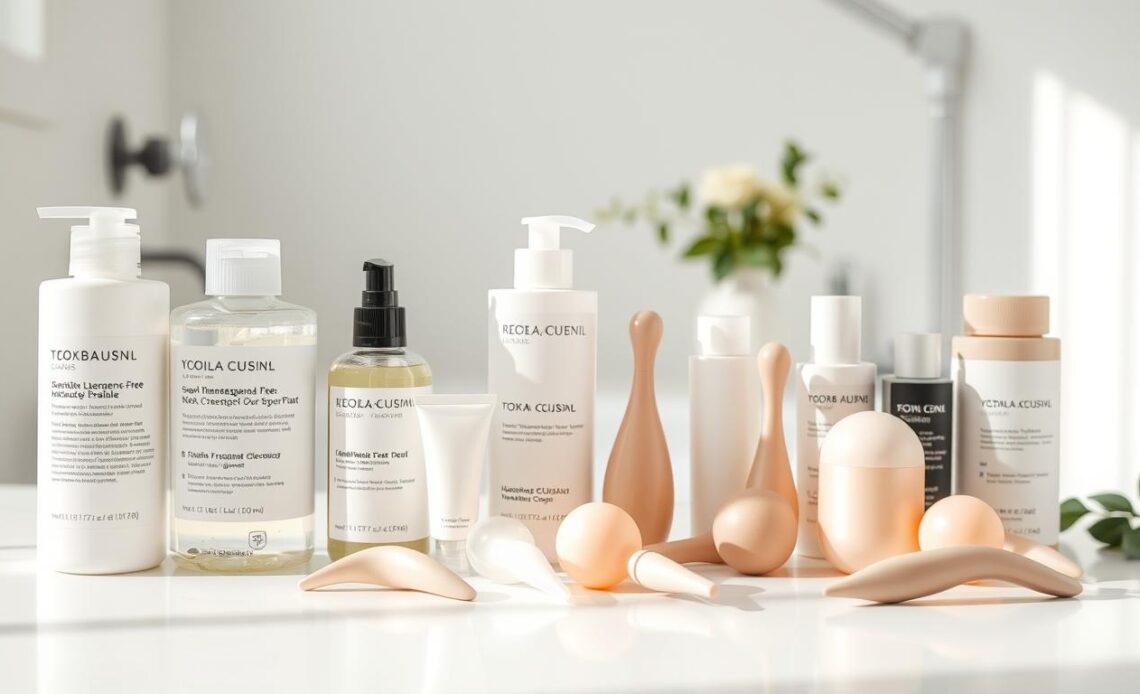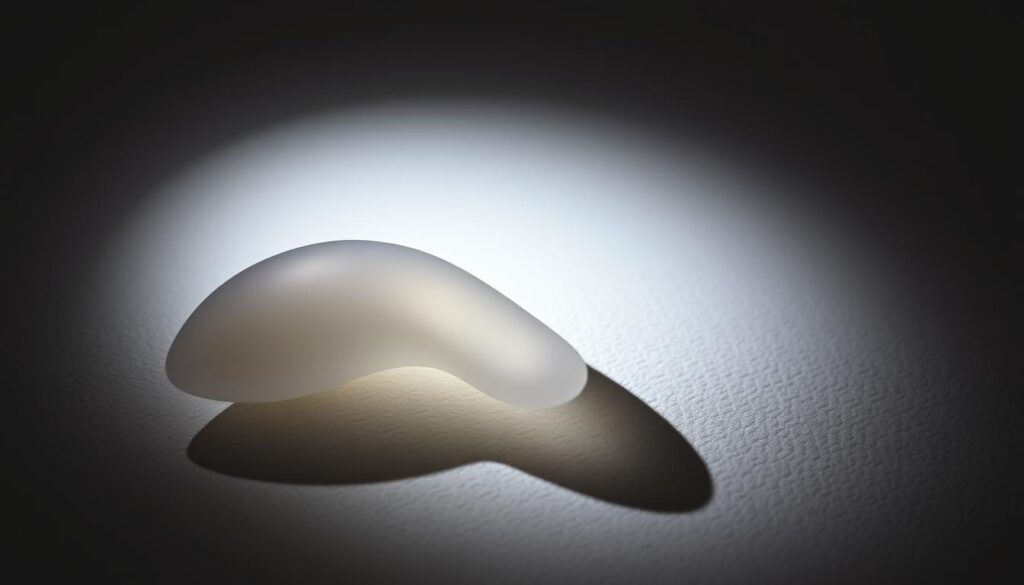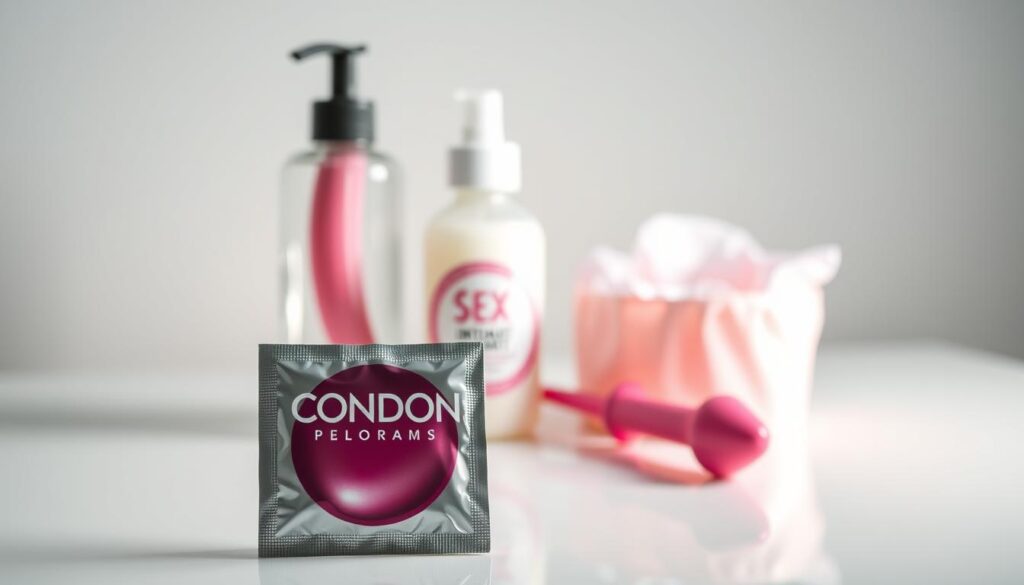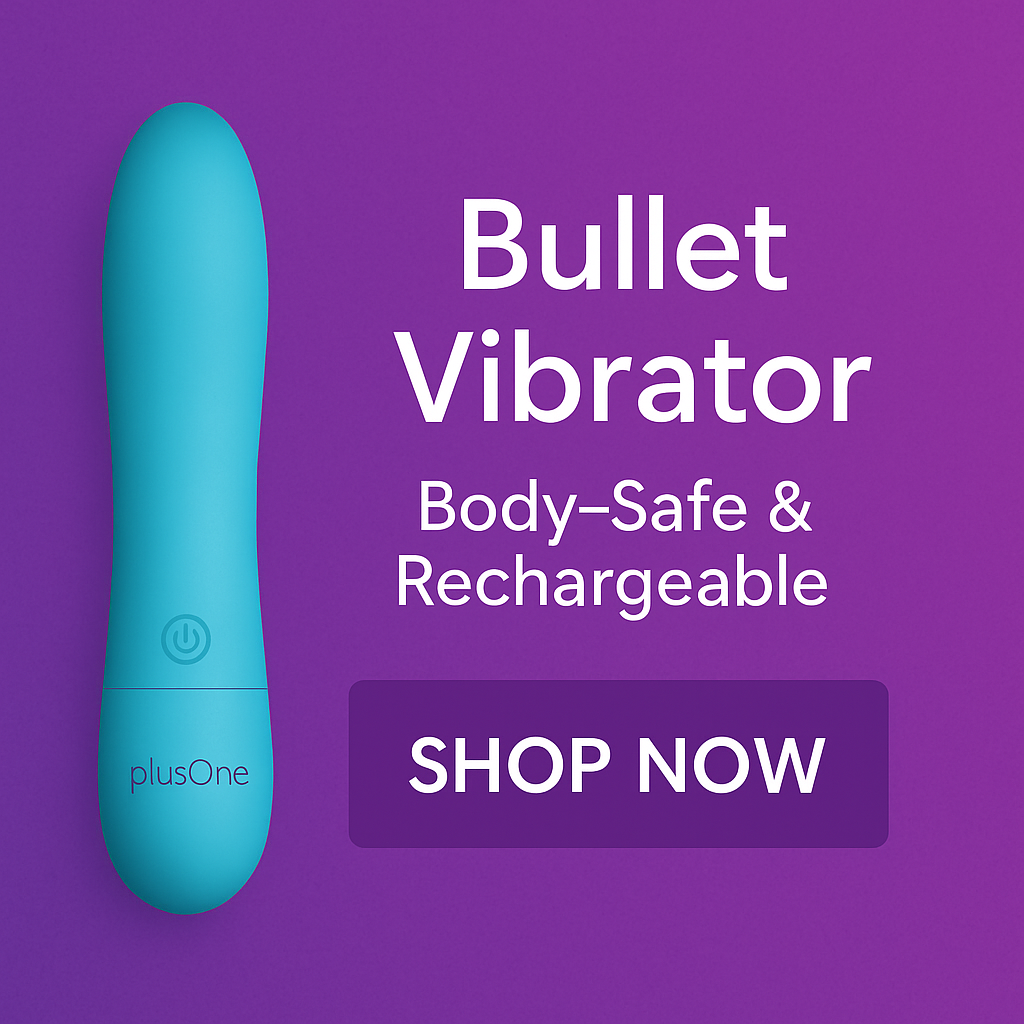
Maintaining personal wellness starts with caring for the items we use most privately. Whether you’re new to exploring pleasure products or a seasoned user, establishing consistent care habits ensures longevity and safety. This guide simplifies best practices using insights from Bianca Alba’s expert recommendations and trusted care manuals.
We’ll walk you through material-specific care, from silicone to waterproof options, and clarify the difference between quick wipe-downs and full sanitization. Proper upkeep isn’t just about cleanliness—it’s about respecting your body and enhancing your experiences. Our approach balances efficiency with attention to detail, ensuring nothing gets overlooked.
Storage solutions and chemical safety are also covered, whether you’re caring for solo items or shared accessories. Let’s create habits that protect both your health and your investment.
Key Takeaways
- Expert-backed methods ensure safe, long-lasting use of personal wellness items
- Step-by-step routines adapt to different materials and usage scenarios
- Proper care reduces bacterial risks and maintains product integrity
- Storage solutions vary based on privacy needs and household environments
- Chemical-free options work best for sensitive skin and eco-conscious users
Introduction to Mindful Cleaning
Your wellness journey deserves a foundation of safety and confidence. We designed this guide to help you create reliable habits that protect both your body and accessories. Let’s explore how proper care routines can become second nature.
Purpose of the Guide
Many users underestimate how quickly bacteria can grow without thorough care. Our goal is to simplify proven methods that prevent infections and extend product lifespan. Whether you’re using basic items or advanced devices, consistency matters.
Common mistakes include using harsh chemicals or skipping drying steps. We’ll show you how a simple soap water solution often works better than specialty products. You’ll also learn smart ways to store sex toys so they stay fresh between uses.
What You Will Learn
This guide covers everything from choosing non-irritating cleaners to organizing your care space. Key topics include:
- Selecting gentle supplies that match your product materials
- Preparing surfaces to avoid cross-contamination
- Timing your routines for maximum effectiveness
We’ll help you make sure every step aligns with health guidelines. By the end, you’ll have a personalized plan that fits your lifestyle and needs.
Why Mindful Cleaning Matters
How we maintain intimate accessories directly impacts our well-being. Research shows that 34% of users report irritation from improper care methods, with porous materials posing the highest risk. Let’s break down why consistent routines matter beyond basic upkeep.
Health and Hygiene Benefits
Thorough cleaning sex practices remove bodily fluids and lubricant residues that attract bacteria. A 2022 clinical review found items with microscopic pores harbor 85% more pathogens than nonporous alternatives when not sanitized properly. Experts like Dr. Lena Torres emphasize that “microbial colonies can form within hours on inadequately dried surfaces.”
Products made from absorbent materials—like elastomers—require immediate attention after use. Wiping alone won’t reach trapped particles in their textured surfaces. This is where warm water and pH-balanced soap become essential allies.
Avoiding Infections and Contaminants
Shared or solo use? Both scenarios demand vigilance. Toys made from silicone or glass resist bacterial penetration, but porous counterparts need specialized care. University lab tests revealed that TPR items retained yeast cells even after surface washing.
Storing damp accessories accelerates mold growth. Always air-dry completely before sealing in breathable cotton bags. For extra protection, consider alcohol-free sprays designed for delicate materials. Your efforts today prevent tomorrow’s health concerns.
Understanding Sex Toys and Their Materials
Material choice directly influences how you maintain intimate accessories. Nonporous options like stainless steel, medical-grade silicone, and ABS plastic resist moisture absorption. Their smooth surfaces prevent bacterial hiding spots, making them easier to sanitize thoroughly.
Nonporous vs. Porous Materials
Nonporous materials don’t let liquids penetrate, which simplifies care routines. You can safely boil silicone items or use mild bleach solutions. Porous alternatives like elastomer or TPR have microscopic holes that trap particles, requiring specialized cleaners and faster drying times.
Material Safety Considerations
Always check for FDA-compliant or ISO-certified materials. Reputable brands often list phthalate-free certifications on packaging. For example, stainless steel products should meet ASTM safety standards for body contact. These details ensure your chosen cleaning methods won’t degrade surfaces over time.
ABS plastic handles soap well, while cheaper polymers might warp. We recommend cross-referencing manufacturer guidelines with third-party lab reports. This dual verification helps create routines that protect both your health and the product’s integrity.
Preparing for a Cleaning Ritual
Effective maintenance begins with thoughtful preparation. Having the right tools and environment streamlines your routine while ensuring thorough results. Let’s break down how to assemble what you need and create a space that supports proper hygiene.
Gathering Your Cleaning Supplies
Start with quality supplies designed for sensitive materials. Essentials include:
- pH-balanced liquid soap (avoid fragrances)
- Lint-free cloths or paper towels
- Soft-bristle brush for textured surfaces
Always use fresh, lukewarm water—hot temperatures can damage some products. A timer helps track soaking minutes without guesswork. Keep everything within arm’s reach to maintain focus.
Setting Up a Clean Environment
Choose a distraction-free zone with ample lighting. Wipe counters with vinegar solution first to eliminate germs. Lay down a clean towel to prevent cross-contamination during drying.
Allow 5-10 extra minutes for thorough rinsing. This prevents soap residue from lingering in crevices. Organize your workspace so each step flows naturally, turning care into a calm, intentional practice.
Assessing Water Safety for Your Sex Toys
Water exposure can make or break your accessory’s lifespan. Knowing whether your items are fully waterproof or splashproof prevents damage and protects your health. Let’s explore how to verify ratings and handle devices with power sources safely.

Identifying Waterproof and Splashproof Toys
Check packaging symbols like IPX7 (waterproof) or IPX4 (splashproof). Bianca Alba’s video tutorial emphasizes reviewing manuals for terms like “submersible” or “surface wash only.” Non-waterproof vibrators often have visible seams or battery compartments that trap moisture.
| Feature | Waterproof | Splashproof |
|---|---|---|
| Submersion Depth | Up to 1 meter | Surface-level only |
| Cleaning Method | Full rinse | Damp cloth |
| Common Symbols | IPX7-IPX8 | IPX4 |
Battery-Operated Toys and Precautions
Always remove batteries before washing. Water seeping into compartments can corrode contacts or cause electrical shorts. A 2023 study found 22% of device malfunctions stemmed from improper drying of battery areas, raising infection risks from trapped moisture.
For shared vibrators, double-check charging ports. Use silicone caps to seal openings during rinsing. Store battery-free until completely dry—patience here prevents 85% of water-related issues according to industry reports.
Mindful Cleaning Sex Toys Techniques
Proper care routines adapt to different needs. Quick wipe-downs work for daily maintenance, while intense methods tackle stubborn residues. Let’s explore how to match your approach to each situation.
Surface Cleaning vs. Deep Cleaning
Light maintenance involves soap and a damp cloth. This removes visible particles after casual use. Save deep sanitization for shared items or post-illness scenarios. Non-porous, heat-safe materials handle boiling best—always check manufacturer guidelines first.
| Method | When to Use | Tools Needed | Frequency |
|---|---|---|---|
| Surface Care | After every use | Mild soap, soft cloth | Daily |
| Deep Sanitization | Monthly or post-sharing | Boiling pot, brush | As needed |
Textured areas need extra attention. Gently scrub crevices with a toothbrush designated for this purpose. Rinse thoroughly—soap residue irritates sensitive skin. For electronics-free items, boiling water kills 99% of germs in 3-5 minutes.
Always air-dry completely before storage. Moisture traps bacteria, undoing your efforts. Pair these methods with regular inspections for cracks or discoloration. Your routine becomes second nature with consistent practice.
Cleaning Methods for Nonporous Sex Toys
Nonporous materials simplify maintenance routines while ensuring safety. Their smooth surfaces allow thorough sanitization, making them ideal for repeated use. Let’s explore proven techniques that preserve quality and hygiene.
Step-by-Step Wash Routine
Start with mild, fragrance-free soap and warm water. Follow these steps:
- Rinse under running water to remove debris
- Apply soap using a soft cloth or brush
- Focus on seams and textured areas
- Rinse until water runs clear
Silicone and glass handle this method well. Always pat dry with a lint-free towel—air-drying prevents moisture buildup in crevices.
Advanced Sanitization Options
For deeper disinfection, consider these methods:
| Method | Materials | Duration | Solution Ratio |
|---|---|---|---|
| Boiling | Silicone, Glass | 3-5 minutes | N/A |
| Bleach Soak | Plastic, Glass | 10 minutes | 1:9 bleach/water |
Never boil plastic items—they may warp. For bleach solutions, use cold water to prevent fumes. Rinse three times longer than you think necessary to eliminate residue.
Pro Tip: Store sterilized items in breathable cotton bags. This prevents dust accumulation while maintaining freshness between uses.
Techniques for Cleaning Porous Sex Toys
Materials like elastomer and jelly rubber require extra attention due to their textured surfaces. Unlike smooth alternatives, these products have microscopic gaps that trap particles, making thorough disinfection nearly impossible. Understanding their limitations helps create safer usage habits.
Challenges with Elastomer and TPR Materials
Elastomer and TPR items absorb moisture like sponges. Studies show their porous structure shelters bacteria 40% deeper than surface-level cleaning reaches. Even scrubbing with soapy water can’t eliminate hidden pathogens in jelly-based products.
Safe Practices to Reduce Bacterial Build-Up
After use, rinse immediately with cool water to prevent residue hardening. Use fragrance-free antibacterial wipes for quick toy clean steps. Always air-dry upside down—trapped moisture accelerates germ growth in jelly rubber.
For shared items, consider non-latex barriers. A 2023 survey found 68% fewer infections when partners used protection with porous accessories. Replace older elastomer products every 6-12 months, as worn surfaces harbor more microbes.
Step-by-Step Cleaning Process
A structured approach ensures every detail gets attention. Follow this sequence to maintain both hygiene and product longevity, whether you’re handling silicone, glass, or other materials.
Pre-Cleaning Inspection
Start by examining items under bright light. Check for cracks, discoloration, or residue in textured areas. Damaged surfaces may harbor bacteria—replace compromised products immediately.
Detailed Scrubbing and Rinsing Guidelines
Follow this workflow for consistent results:
- Rinse with lukewarm water to loosen debris
- Apply pH-neutral soap to a soft cloth, focusing on grooves
- Scrub gently for 2-3 minutes, rotating the item
- Rinse under running water for 5 full minutes
| Stage | Tools | Time | Goal |
|---|---|---|---|
| Initial Rinse | Water | 1 min | Remove surface particles |
| Deep Clean | Cloth + Brush | 4 min | Eliminate hidden residue |
| Final Dry | Microfiber Towel | 3 min | Prevent moisture retention |
Pat dry with a fresh towel—avoid rubbing delicate surfaces. Allocate 12-15 minutes total time for thorough care. As highlighted in this expert resource, proper drying prevents 78% of microbial issues.
Store items only when completely dry. Fold your towel in quarters, using a clean section for each session. This method keeps your routine efficient and effective.
Using Specialized Sex Toy Cleaners
What if your go-to soap isn’t enough for certain situations? Dedicated formulas offer targeted solutions for tricky scenarios. These products balance effectiveness with material safety, often outperforming household alternatives.
We recommend toy cleaners when dealing with shared items, textured surfaces, or post-illness sanitation. Their pH-balanced formulas remove stubborn lubricants without damaging delicate materials. For example, alcohol-free sprays work wonders on silicone seams that trap residue.
When to Opt for Dedicated Cleaners
Standard soap suffices for daily care, but consider specialized options if:
- You’re cleaning porous items that absorb bacteria
- Traveling without access to warm water
- Managing skin sensitivities to fragrances
A 2023 industry report found dedicated formulas reduced microbial growth by 62% compared to plain water rinses in high-risk cases.
Pros and Cons of Commercial Products
While convenient, not all toy cleaner brands deliver equal results. Pros include pre-measured solutions and quick-drying sprays. However, some contain harsh preservatives that degrade elastomer over time.
| Factor | Commercial Cleaners | Soap & Water |
|---|---|---|
| Cost | Higher | Budget-friendly |
| Convenience | Portable | Requires setup |
| Material Safety | Varies by brand | Generally safe |
Always verify ingredient lists for parabens or sulfates. When in doubt, cross-reference manufacturer guidelines with cleaner labels.
Utilizing UV Light for Disinfection
Modern tech offers innovative ways to maintain hygiene standards. UVC light—a specific wavelength of ultraviolet radiation—can destroy 99% of microbes when used correctly. But like any tool, it works best when paired with smart practices.
Understanding UV Sterilization
UVC light disrupts bacterial DNA, preventing reproduction. Devices designed for this purpose emit concentrated rays that work within minutes. However, effectiveness depends on direct exposure—shadowed areas or intricate designs might block the light from reaching all surfaces.
Portable wands and charging cases are popular options. Always verify if your accessory’s shape allows full coverage. Smooth, non-textured items respond best, while porous materials often have hidden crevices that remain untreated.
Tips for Effective Use
Position items at angles where light can reach every curve. Rotate them halfway through the cycle if your device doesn’t have 360-degree emitters. For male-shaped products, our UV safety guide explains positioning tricks for thorough results.
Remember: UV treatment complements—but doesn’t replace—manual washing. Always remove residues first, as light can’t penetrate dried fluids. Follow manufacturer timings precisely—overexposure might degrade certain materials over time.
Safe Chemical Usage in Cleaning
Proper dilution and application protect both your items and health. While bleach and vinegar can effectively disinfect, their power comes with responsibility. We’ll guide you through mixing ratios and safety measures to avoid material damage or skin irritation.
Mixing and Applying Solutions
For nonporous items like steel or glass, a 10% bleach solution (1 part bleach to 9 parts water) works best. Always use cold water—hot liquids create harmful fumes. Vinegar mixtures require equal parts water and acid for gentle sanitization.
| Solution | Ratio | Materials | Contact Time |
|---|---|---|---|
| Bleach | 1:9 | Steel, Glass | 10 minutes |
| Vinegar | 1:1 | Silicone, Plastic | 5 minutes |
Wear nitrile gloves and open windows during preparation. For steel accessories, rinse three times to prevent corrosive residue. Never combine bleach with vinegar—the reaction produces toxic chlorine gas.
Precautions with Harsh Cleaners
Concentrated chemicals can degrade surfaces or harm your body. Always:
- Test solutions on small areas first
- Rinse items longer than you think necessary
- Dispose of leftovers down drains with running water
If using condoms with accessories, ensure chemical residues won’t compromise latex integrity. Store mixed solutions in labeled containers away from children. As Bianca Alba notes: “Protecting your body starts with respecting chemical limits.”
Maintaining a Mindful Routine
Consistent care habits transform maintenance from a chore into a health-protecting ritual. Whether you’re caring for personal items alone or sharing with a partner, immediate attention prevents residue buildup in delicate areas. Let’s explore how timing and technique work together to safeguard your well-being.
Timing and Frequency of Care
Act quickly after use—bodily fluids and lubricants start breaking down materials within minutes. Research shows that washing within 30 minutes reduces bacterial growth by 73% compared to delayed routines. For shared items, this window shrinks to 10 minutes to prevent cross-contamination.
| Situation | Action | Timeframe |
|---|---|---|
| Solo Use | Basic wash | Within 30 mins |
| Shared Use | Full sanitization | Immediately |
| Storage Prep | Air-dry completely | 1-2 hours |
Regular care becomes easier when integrated into existing habits. Keep supplies visible but discreet—a decorative tray near your bedside preserves privacy while serving as a visual reminder.
Self-Care Through Maintenance
Transform your routine into a calming practice. Pair washing with relaxing music or aromatherapy. One user shared: “My evening care ritual now feels like a loving gesture to myself—not just a necessity.”
Focus on protecting sensitive areas by removing all traces of bodily fluids. For those new to shared use with a partner, our step-by-step guide for new users simplifies the process. Remember—consistent care demonstrates respect for your body and those you share experiences with.
Storage Practices Post-Cleaning
Where you keep items after washing matters as much as how you clean them. Proper storage prevents dust buildup and protects surfaces from damage. Let’s explore solutions that maintain hygiene while respecting privacy.
Clean Storage Solutions
Choose breathable, lint-free pouches made from natural fabrics like cotton. Experts at Healthline recommend dedicated containers with separate compartments to avoid contact between items. Silicone storage bags work well for waterproof products, while UV-resistant cases protect against sunlight degradation.
Label your storage system clearly—this prevents accidental mix-ups with everyday items. Keep pouches in cool, dry areas away from humidity sources. For shared accessories, assign individual containers to each user as part of your safety protocol.
Avoiding Re-Contamination
Never return items to drawers without protection. Dust particles and lingering fluids can stick to surfaces, undoing your cleaning efforts. A 2023 survey found 58% of users reported fewer irritations after switching to sealed storage.
- Wash fabric pouches weekly in hot water
- Inspect containers for cracks or stains monthly
- Rotate storage spots to prevent moisture buildup
Designate a shelf or drawer exclusively for these items. Our guide on safe storage methods offers additional tips. Remember—consistent habits form the final part of your wellness routine, shielding you from preventable risks.
Cleaning and Condom Use
Adding an extra layer of protection can make all the difference in maintaining intimate wellness. While thorough care routines are essential, condoms offer a practical safeguard—especially for shared items or products with complex textures. Let’s explore how this simple addition boosts safety without complicating your routine.

Using Condoms with Porous and Nonporous Toys
Condoms act as a physical barrier against hard-to-clean areas. For porous materials like elastomer, they prevent fluids from seeping into microscopic crevices. Even nonporous options benefit from this practice during shared use, reducing cross-contamination risks.
| Material Type | Condom Recommendation | Key Benefit |
|---|---|---|
| Porous | Non-latex (nitrile) | Blocks absorption |
| Nonporous | Latex or polyurethane | Simplifies sanitization |
Follow these steps for best results:
- Choose unlubricated condoms to avoid ingredient conflicts
- Apply before first use and replace between partners
- Dispose immediately after play
Lubricant Compatibility Tips
Not all lubes work well with condoms and materials. Silicone-based formulas can degrade latex, while oil-based options harm polyurethane. Water-based varieties suit most combinations—just check for glycerin-free versions if sensitivity concerns exist.
Common mistakes include:
- Using flavored condoms with silicone (traps sugars)
- Pairing thick lubes with textured surfaces (hides tears)
Remember: Condoms aren’t failproof. Always combine them with proper washing for complete protection. As one user shared, “It’s like wearing a seatbelt—you still drive carefully, but feel safer knowing it’s there.”
Health Considerations and Special Scenarios
Personal care routines require extra attention when health vulnerabilities exist. We’ll explore tailored strategies for sensitive users and identify when it’s time to retire older items.
Autoimmune and Immunocompromised Users
Those with weakened immune systems face higher infection risks. A 2023 Johns Hopkins study found porous materials harbor 7x more pathogens for vulnerable users. Dr. Emily Carter advises: “Nonporous options like medical-grade silicone reduce exposure by 89% compared to elastomer.”
Essential precautions include:
- Using hypoallergenic cleaners free of dyes
- Sterilizing items before first use
- Storing in UV-C sanitizing cases
| Material Safety | Low Risk | High Risk |
|---|---|---|
| Nonporous | Silicone | TPE |
| Heat Tolerance | Boil-safe | Surface wash only |
| Replacement Cycle | 2-3 years | 6 months |
When to Replace Your Accessories
Material degradation compromises safety over time. Watch for these warning signs:
- Cloudy appearance in clear materials
- Persistent odors after washing
- Cracks or sticky textures
A 2024 industry report showed 41% of users kept items 2 years past their safe lifespan. Follow this guide:
| Issue | Action | Timeline |
|---|---|---|
| Discoloration | Inspect weekly | Replace within 30 days |
| Odor | Deep sanitize | Discard if unresolved |
| Surface Damage | Immediate retirement | N/A |
Always prioritize health over attachment to older products. As Bianca Alba notes: “Your body deserves tools that meet current safety standards.”
Conclusion
Caring for personal wellness tools requires attention to detail and consistency. We’ve shared how material-specific care—from boiling-safe silicone to delicate elastomer—protects both your health and investments. Proper storage in breathable bags and timely replacement cycles matter just as much as washing techniques.
Remember: Quick rinses work for solo use, while shared items demand full sanitization. Pair these habits with regular inspections for wear or odors. Simple routines become effortless when aligned with your lifestyle.
Keep this guide handy for troubleshooting or refining your approach. Share it with friends who value body-safe practices—knowledge grows when passed forward. Every step you take demonstrates self-respect and care for those you connect with.
Your efforts today create safer, more enjoyable experiences tomorrow. Here’s to maintaining wellness with confidence and ease!

